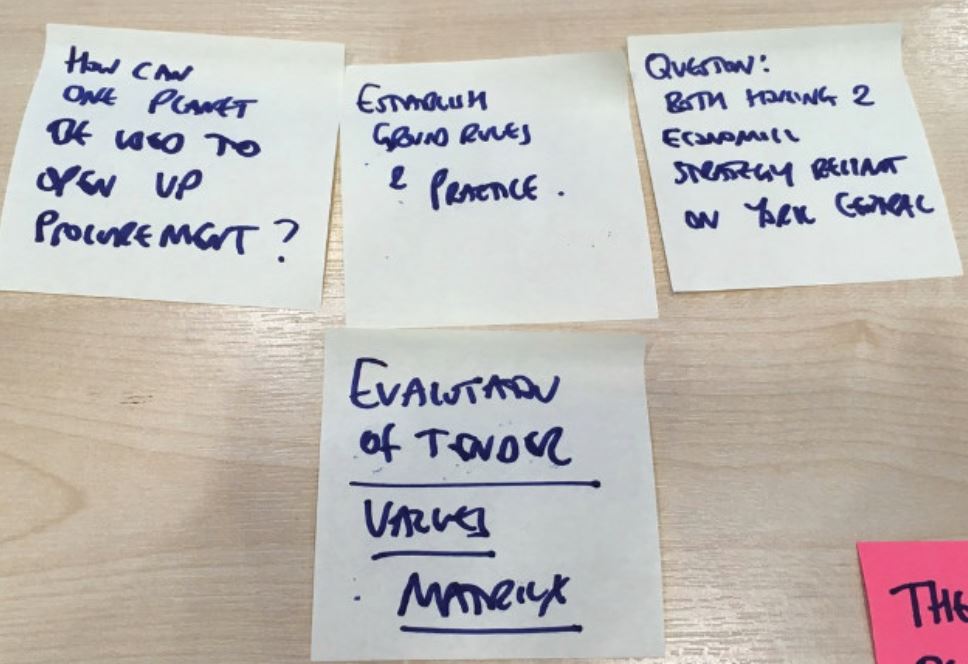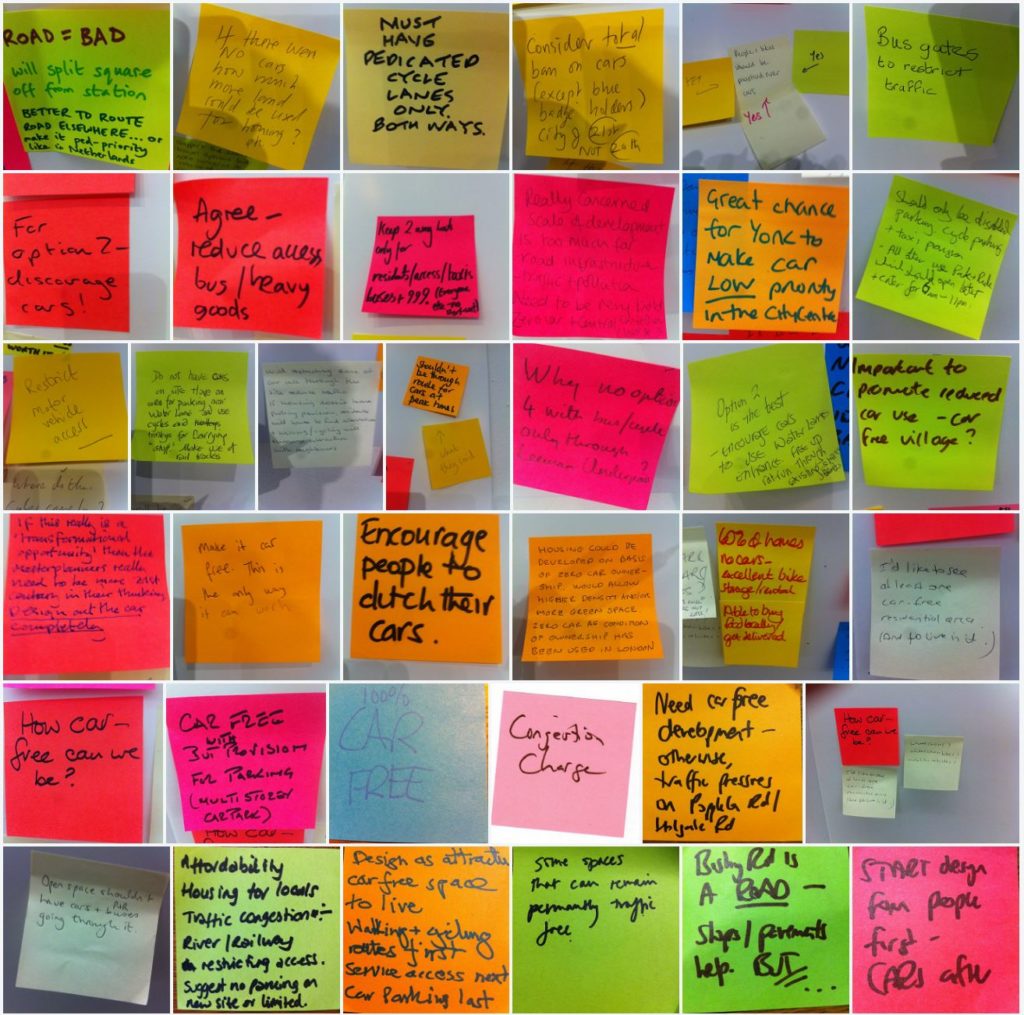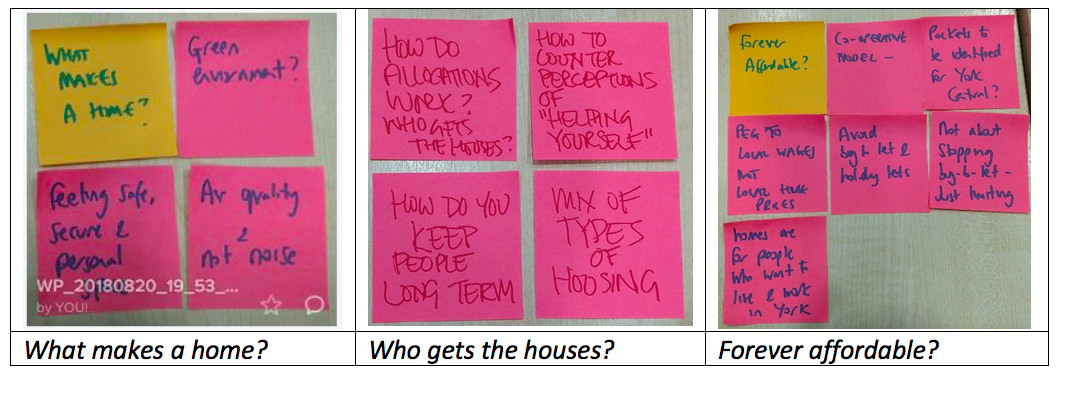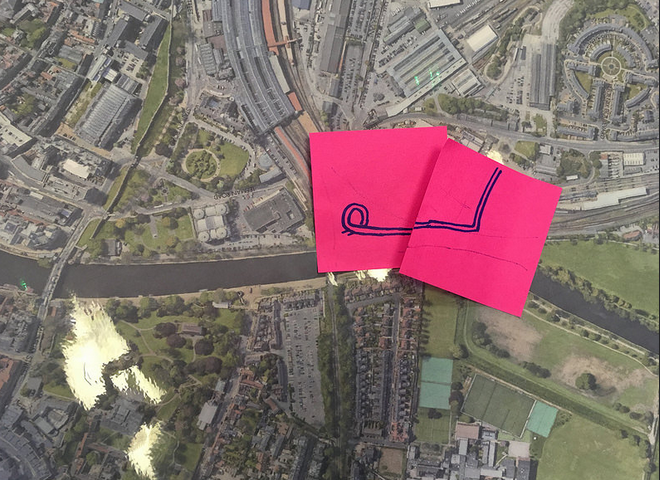8th August 2018
Although the economics of large-scale developments are complex, the aim of the ‘How viability will shape York Central’ workshop was to explore the basic principles in as straightforward a way as possible. We have heard many times that York Central is “expensive”, but we want to explore how expensive, and what implications might this have? How much does it drive questions of density and building height, and does it restrict – or conversely encourage – opportunities to pursue innovative ideas within the development?
Tamsin Hart-Jones, York Central Partnership began by introducing the headline figures related to the overall viability of the site. We were also joined by Andy Dainty, director of Urbo Regeneration, a developer of similar, challenging large-scale mixed-use projects. Andy has no commercial interest in York Central but has a background in regeneration/consultation and was simply invited to join us on the recommendation of David Rudlin to help open up an informed discussion.
Tamsin Hart-Jones, York Central Partnership
Tamsin began by noting that the numbers are illustrative. The numbers give an indication and viability is something which evolves over time and is a work in progress. (Andy later referred to this as “knowing something is capable of being viable, rather than that it *is* proven to be viable”).
Viability on York Central is thought about through a two-fold approach.
- ‘Off-plot’ infrastructure (e.g. main access; new pedestrian and cycle connection) that will open up the site
- ‘On-plot’ (build costs and values)
‘Off-plot’ infrastructure
Significant challenges:
- Site bounded by railways
- Existing use clearance
- Remediation (hot spots that need to be treated)
- Cross site earthworks (level changes in that area, e.g. the changes in level you can see when you come out of Marble Arch and look towards the NRM)
Estimated costs: c. £150m
Funded through public grant funding: Housing Infrastructure Fund (grant funding), Enterprise Zone Borrowing (CYC can borrow against the expected income from business rate retention), WYCA Transport + Funding (grant funding) (CYC has applied for that, by January aim is to have a number of funding approvals in place).
(The development appraisal doesn’t / can’t cover this type of off-plot infrastructure).
The infrastructure will be delivered by the York Central Partnership or the City of York Council. In the Council’s June 2018 Executive report, they had approval to go out for procurement. The Council will adopt the road so the Council delivering the access road might make sense. YorCivil2 Framework will probably be used to get contractors.
The off-plot infrastructure is about creating serviced plots.
Off-plot benchmarking
The numbers are developed by looking at other examples. You add value by spending money on key areas (e.g. coal drops and new square, and landscaping will need to be to a high standard).
‘On-plot’ Development Appraisal – cost assumptions
Build costs
- Offices – £111-£160 per sq. ft
- Homes – £139-£163 per sq. ft
- Retail – £93 per sq. ft
- 3% contingency
(note all being updated based on Quarter 2 2017 build costs)
Professional fees 12%
Developer profit at £17.5% for residential and 15% for commercial.
The aim of YCP is ‘to de-risk the site’ by carrying out ground investigations, achieving outline planning consent and putting in the off plot infrastructure so that all bids are based on same understanding of the site.
Section 106 (sets out how developers will contribute to the development e.g. affordable housing / community facilitates) with the YCP proposals including an assumption of 20% affordable housing. The council is looking at whether they can increase the amount of affordable housing on the site by doing more themselves.
Finance – interest rate of 5.5%
Purchasers costs at 6.8% ( stamp duty; agency and legal fees ) the costs for someone to buy the completed development as an investment.
Appointed Savilles as commercial advisors on the site, Turner & Townsend are giving cost advice.
On-plot – revenue assumptions
Offices £15-£23 per sq. ft (annual rental value)
Retail £15-£17.5 per sq. ft (ancillary retail e.g. local co-op/ independent store) (annual rental value)
Residential – £375-£400 per sq. ft (local comparable Chocolate Works and Hungate) (capital sale value)
Q: Why do costs escalate?
York Central has a funding envelope, only a certain amount of funding. You won’t know until you go out to market and receive tendered prices back. We have to make assumptions around it. There is a risk contingency. The figures can change but need to work within the funding envelope. There will be choices to make.
Q: The examples of Chocolate Works and Hungate are exactly what we don’t want
These are just comparables, they are market evidence in terms of what is happening in York and then we will go out to the market, examples of what could be delivered on this site. Whatever we choose to do at below market value, this tells us where the market values are.
Q: How are you going to make 20% actually affordable? The danger is that rent on The Chocolate Works for a 2 bedroom apartment is £1200 per month plus service charge and so 80% of that is still very expensive.
CYC and YCP looking at social rent through to discount for sale, a wide range of tenure.
Q: There is a difference between government jargon and how people in York see and experience affordability
That will be agreed through the Section 106 through the planning process. That is not something that will be down to the developers.
Q: what will be the structural role of the council in terms of these discussions? [returned to below]
On-plot Appraisal Summary
| Gross development Value
|
£665m |
| Net Development Value (gross minus purchaser’s costs) |
£647m
|
| Development and construction costs |
£554m
|
| Of which Residual Land Value – reply as Homes England and Network Rail for the investment made in the site through land acquisitions, relocation costs, site clearance costs
|
£55m (£1m per acre) |
| Developers margins
|
15-17% |
Q: What about the council land?
This appraisal is only based on Homes England and Network Rail land and not the CYC 5% ownership.
Q: Have we looked for lots of different funding partners? E.g. NHS
Often public money is just loans rather than grants. Here it is clear that there is no site without massive infrastructure investments.
Q: There is no economic champion for the site, it is mostly housing. You seem to have a “one size fits all” procurement approach. You need to go out to partners and users first, not developers first.
Andy Dainty: It is a difficult place for a ‘pioneer’ i.e. the early occupiers before the character of the place has improved. On Day 1 it is difficult to get someone to jump in but maybe easier when it is half developed. The “unpalatable” high value residential will pay the bills – offices won’t pay the bills and low cost housing won’t pay the bills. The percentage developer profit should relate to the amount of risk they are taking and resource/funding provided (e.g. building roads).
Tamsin: What we haven’t done yet is soft market testing the site. That is because we need to get to the point where we have a site that works, with planning consent, we will then be asking a whole range of people. We have asked the council to be clear about the economic sectors we should be targeting. We need an anchor tenant that draws other people to come around them.
Q: The language is important, we should go and talk to users and partners rather than just ‘take it to the market’.
Andy Dainty’s example of how volatile viability is:-
|
Base |
– assumptions/outcomes |
+ assumptions/outcomes |
|
|
+/- 5% |
+/- 5% |
| Total Development Value |
110 |
105 |
116 |
| Total Development
Costs |
100 |
105 |
95 |
| Residual Value (margin) |
10 |
-0.5 |
21 |
| This is why it is volatile – Small changes in the many variables an appraisal comprises impact disproportionately on the viability. |
|
-100
The margin has gone altogether |
+100
The margin doubles. |
|
|
|
|
We are exploring in this event ‘how does viability work?’ – but the real question is what does it mean?
At the front end we tend (prudently) to worry about the worst case. This makes it harder to commit to non viable but desirable elements of a scheme ‘up front’
Doesn’t mean you can or can’t get affordable houses and other things the community wants. But it informs how you approach it. You need to add value that will come back. It needs a sensible grown up partnership so that all partners share the business of adding value – e.g. placemaking. It might include loss leading items but adds value.
What can be said: we can’t promise to do that (e.g. high % affordable housing) because values change but we will work towards it and try to add value. In terms of a strategy, it helps get over the bumps of the infrastructure. The contractual basis then needs to underpin this however.
Offices do not make much money. High cost high value makes a margin but not necessarily more than lower cost lower value managed workspace.
The residential seems thorny. If we need to recover a large chunk of the costs, only open market residential will do it. Doesn’t mean you do 2500 units. But density becomes interesting. Apartments make land value because you are stacking value. Houses are not capable of getting to those land values. How much “affordable” can York Central afford? It would be better not to fix this up-front, but rather design a process that is responsive and might lead to a higher percentage if ‘extra’ financial surpluses allow during delivery and over the project lifetime. For example, a development agreement could specify that if the developer profit or sales values exceed a certain level, there is a commitment to deliver additional community facilities or affordable housing.
Q: Is it advantageous for York Central to make it a longer process?
Public sector could back it by keeping a stake in it.
You could have a partnership which says if it goes badly it is the developer’s risk/problem, but if it goes well then the developer can invest afford to contribute more. The advantage of building in flexibility is that developers will look pessimistically. Whereas the public sector tends to look optimistically. The partnership works better when you align the interests up front rather than relying on the planning process. And then everyone tries to make it go better and afford ‘extra’ benefits. If not, you share the pain (but funding for extra benefits was never in hindsight really there).
Q: Who is going to be part of the partnership? The Council needs to be involved in the partnership as they are sharing the risk, where are our share the benefits going to be?
Tamsin: We are all public sector bodies. The Council owns 5% of the overall site – a relatively small stake in terms of land. But infrastructure costs require HIF Homes England and the input of two major public landowners. There would be a separate conversation about leading on procurement. How the funding goes in and where overage would come out. The collaboration agreement is about the developer partners. It is not yet a done deal – merely that there *will be* an agreement.
One of the defining features of this scheme is 20% affordable. 20% is council policy but that is subject to a viability test. Usually, on the way everyone makes noises about the 20% then the developer shows it is not viable so you end up with 3% or 5%. The council and YCP have said York Central has to deliver 20%. That makes this scheme massively different from most developments.
Andy: I would always advise a council that if there is an attempt to control it through the planning process then it will likely get compromised. There is more teeth in a partnership agreement and development agreements with delivery partners than just through planning. Where willing partners own all the land as here, greater control through tenure/development contracts is possible (and recommended).
Q: Thank you for giving us the numbers and I want to see this site develop but it is not viable. I want to see something happen here. York Council taxpayer own 5% site, but all the risk will fall on the York tax payer if you’ve got your numbers wrong. The Enterprise Zone assumption that if you can rent them out then we can recover the business tax. But what is the demand for offices? The answer from CYC has been ‘build it and they will come’. Offices are being turned into homes. I want to hear a more realistic approach. What is Plan B. Has anyone said it might be worth starting to do some house building now rather than first putting in all this infrastructure.
Tamsin: What can we do without £150m infrastructure? York Central only has capacity for 400 homes with the current highways infrastructure. There is a question about that, could you have 400 homes delivered? You might not get planning for part of the site as there would be a desire to have certainty around the whole site. Without that upfront infrastructure it is not possible to move forward. There have been refusals already.
Q: Why not create cash flow early by building 400 homes now. Instead of waiting for the fictitious return from the Enterprise Zone.
Tamsin: The Enterprise Zone work is underway and will go through the City of York Council.
Q: The council needs to be more transparent about its evidence.
Q: Is a public-private partner realistic as there is government pressure on Homes England and Network Rail. What is Homes England policy on a public-private partnership or if they were supportive of the principle would they look to someone else to lead that?
Tamsin: We don’t have a policy position. We consider things site by site, what are the challenges in that area. Homes England and Network Rail have to recover investment and have targets around delivery of houses. You have surplus brownfield land, you need to use it for housing delivery. Homes are central to Homes England’s business, and for Network Rail delivering homes is one of a range of things they have to think about. In partnership with the council as master developers we are taking out an element of risk and we are maximising the value we can create in that way. Do we have a partner on board? It is an open conversation at the moment. It could be we end up in partnership for the whole site or for part of the site. There is a whole range of options, as I mentioned. The soft market testing will inform the decisions we make.
Q: What are the drivers in terms of when you will make that decision?
Tamsin: It is being informed by minimising risk. We want to minimise risk to get the best value for the public purse. There are still uses and so we haven’t yet been able to do the land investigations needed to create certainty before going out to the market. We’ll start soft market testing by summer 2019, we’ll be clear about how to go out to the market across the site. My aspiration is that we take some of the earlier plots, this time next year, to the market. That would be early delivery.
Q: I am more concerned about investment attraction. Whatever they might think they want, what the council may want is one aspect only. We need to look at who is interested in coming here. It is the Enterprise Zone money that we need.
Tom Devine: There is a lot happening in the wider Yorkshire office market. In Leeds, with government office and the land take for HS2, plus land take for the new expanded station, the Leeds office market is going to come under massive pressure. I believe a significant proportion of the office market for York Central will come from people in out of town business parks around Leeds and the M62 corridor. If you talk to the people that run those businesses in those locations there are a number problems. They are not well served by public transport. The problem they have is they cannot hold on to junior staff because people take an equivalent job in the City centre as soon as they can. Car parking is also often difficult. When owners/managers of those businesses get to a point of lease renewal and could have a new building at York Central, next to mainline station and all the social infrastructure and facilities of the city centre next door, for the same cost as renewing their lease on an out of town business park, I am convinced that York Central will be a far more compelling option.
The issue is that you can’t have these conversations until you have planning consent – you get one shot at them so timing is crucial. A lot of property is controlled from London. If you mention York they say, ‘Lovely place, don’t bother’ – it has a perception in the property sector for not being able to deliver. Talk to some of the businesses that have tried to deliver and failed. Hiscox really wanted to be here and they went through the pain barrier of getting land and planning permission, but they are an exception not the rule Getting outline planning consent for York Central will change that.
In York Central we should be looking for early wins of hotels and residential. If you look beyond York and to the wider market what we are offering is new buildings, a strong talent pool of good schools and two universities as well as proximity to a mainline train station. It is a compelling offer. Grade A on top of the station is what changes the conversation about offices in York. I worked on the economic impact assessment of Crossrail in London in 2004, I had to assess what difference it would make in 20 years. When I went to Maidenhead, local agents were saying Crossrail isn’t going to make a difference. But it has, by increasing demand and property values by 270%. Transport has demonstratively had a big impact on property values.
Andy: Transport is always one of the most important factors in office choice.
Final questions which lack of time meant we could not address, but will follow up:-
Q: The potential role of local communities in the development? The value of community input.
Q: What does affordability mean? There are signs that the formula of 80% of market rent might not be affordable for many in York. Local affordability standards could be a follow up event.
Q: Role of the partnership and transparency in terms of the green book appraisals.
Q: Can we prove the demand? Can there be more transparency and openness?



